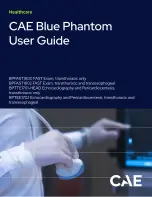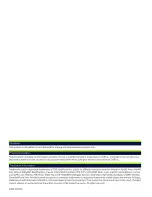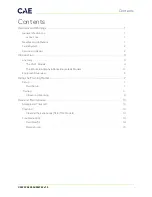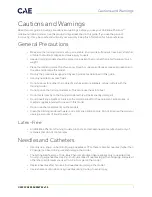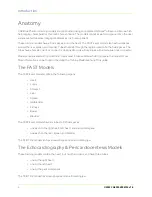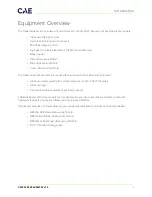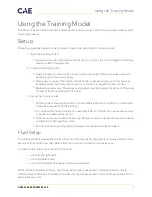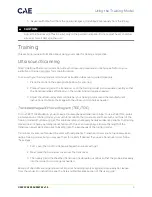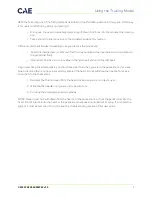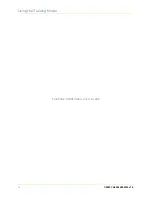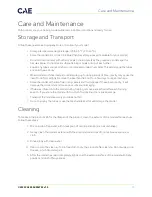
©2022 CAE 905K004752 v1.0
1
Cautions and Warnings
Cautions and Warnings
Read this user guide, including all cautions and warnings, before you use your CAE Blue Phantom™
ultrasound training model. Use this product only as described in this guide. If you use the product
incorrectly, it may be unsafe and will void your warranty. Keep this information for future reference.
General Precautions
• Make sure the training model is set up on a stable, sturdy work surface such as a bed, stretcher,
or table that will not collapse and cause injury to users.
• Heavier training models should be placed on a patient bed or stretcher rated to support such
weight.
• Place the model on smooth surfaces only. Rough or uneven surfaces can leave impressions on
the skin and damage the model.
• Do only the procedures supported by each product as described in this guide.
• Use only needles to access fluids.
• Do not use or store other sharp objects such as scissors, scalpels, or box-cutters with the
training model.
• Do not pull on the training model skin. This can cause the skin to tear.
• Do not mark directly on the training model as this will permanently damage it.
• Do not insert any objects or tools into the model except for the equipment, accessories, or
medical supplies intended for use with this model.
• Do not use chemical solvents on the models.
• Clean the training model with water and a light soap solution only. Do not immerse the model or
use large amounts of liquid to wash it.
Latex-Free
• All CAE Blue Phantom training models, products, and accessories are manufactured only of
materials that do not contain latex.
Needles and Catheters
• Use only new, sharp, unbent 18-21 gauge needles or 7F catheters. Smaller needles (higher than
22 gauge) can bend during use and damage the model.
• The self-healing feature of CAE Blue Phantom simulated tissue applies only to needle sticks
from 18-21 gauge needles. Healing is not guaranteed if needles larger than 18 gauge, scalpels, or
other sharp implements are used to cut into or pierce the model.
• Replace needles after ten uses. Dull needles can damage the model.
• Use extreme caution when using needles during training to avoid injury.
Summary of Contents for Blue Phantom FAST Exam Ultrasound Training...
Page 1: ......
Page 2: ......
Page 4: ...Contents ii 2022 CAE 905K004752 v1 0 THIS PAGE INTENTIONALLY LEFT BLANK...
Page 10: ...Introduction 6 2022 CAE 905K004752 v1 0 THIS PAGE INTENTIONALLY LEFT BLANK...
Page 16: ...Using the Training Model 12 2022 CAE 905K004752 v1 0 THIS PAGE INTENTIONALLY LEFT BLANK...
Page 20: ...Care and Maintenance 16 2022 CAE 905K004752 v1 0 THIS PAGE INTENTIONALLY LEFT BLANK...
Page 21: ......

